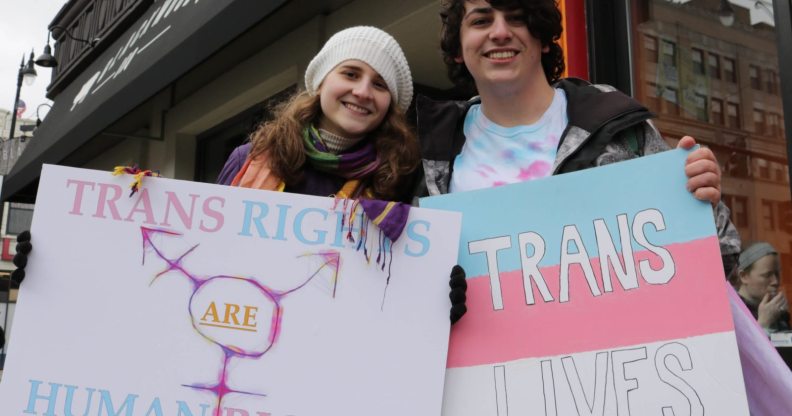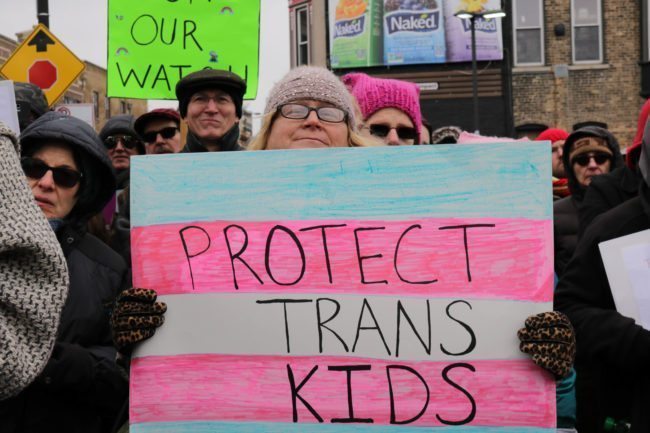Schools to begin rolling out ‘transgender toolkit’ guide to support students

(Getty)
Minnesota will begin rolling out a ‘transgender toolkit’ to schools across the state to support teachers and parents in creating a gender-inclusive environment.
The guide tells schools to “not assume a student’s name or pronoun,” and to make sure to always ask.
“When students are referred to by the wrong pronoun by peers or school staff, students may feel intimidated, threatened, harassed or bullied,” the toolkit states.
The “toolkit” was approved on Wednesday by the School Safety Technical Assistance Council, and distributed to all state schools from age 5 – 18 throughout Minnesota.
Its aim is to “ensure a safe and supportive transition” for children becoming a different gender at school.

(Getty)
The guide stresses the importance of removing gendered language where possible, such as calling the children “students” or “scholars” rather than “boys and girls.”
It suggests tips such as nominating “prom ambassadors,” “homecoming court,” or “homecoming royalty,” rather than “kings and queens.”
The Minnesota Department of Education says acceptance and support of a child’s gender identity is an important factor in their well-being and achievement at school.
It explained: “Safe, supportive and welcoming schools play a pivotal role in ensuring students are engaged in learning and that nothing hinders their ability to achieve their best in the classroom.
“The School Safety Technical Assistance Council seeks to help all schools in Minnesota ensure that all students in Minnesota regardless of their color, race, religion, gender or sexual orientation are afforded a safe, supportive and welcoming school environment where they can achieve success.
“Ensuring that transgender and gender nonconforming students are safe and supported in school has been an emerging issue throughout the nation and in school districts and charter schools throughout Minnesota.
“During the last three years, an increasing number of school and school district administrators and staff members as well as students and families have contacted the Minnesota Department of Education and the School Safety Technical Assistance Center seeking technical assistance on how to ensure safe, supportive and inclusive environments for all students, including transgender and gender nonconforming students.
“In response, the council, which oversees the center, formed a workgroup to develop this toolkit to help school districts and charter schools create school environments where transgender and gender nonconforming students are safe, supported and fully included, and have equal access to the educational opportunities provided to all students as required by federal or state law.”
The department says no legal documents are needed to change a student’s name or gender in school records.
The guide discusses the hotly-debated issues of bathrooms and locker rooms, and says that students who feel uncomfortable in these situations should be separated.
Related: Trans boy in Florida sues school district after being denied bathroom rights
“Privacy objections raised by a student in interacting with a transgender or gender nonconforming student may be addressed by segregating the student raising the objection provided that the action of the school officials does not result in stigmatising the transgender and gender nonconforming student,” it says.
Currently, in Pennsylvania a student is suing his school district on the grounds of sexual harassment and privacy violation, when a transgender boy use the boy’s locker room
The toolkit links to several outside resource guides, including the group Gender Spectrum’s “Student Gender Transition Plan” – a form where a child can fill out their “preferred name,” gender, and assigned sex at birth.
The department also references a “Guide for Supporting Transgender Students in K-12 Schools,” developed by left-wing organizations such as the Human Rights Campaign, the ACLU, the National Education Association, and the National Center for Lesbian Rights.
This guide states that a child’s “age and maturity” should “never be a basis for denying a transgender student an opportunity to transition in a safe and supportive environment.”

